|
|
|
Sort Order |
|
|
|
Items / Page
|
|
|
|
|
|
|
| Srl | Item |
| 1 |
ID:
184390


|
|
|
|
|
| Summary/Abstract |
Systemic shift, in which the weight of the global economy has shifted away from the Euro-Atlantic eastwards, is increasingly underlined by what is referred to here as the ‘Asianisation of Asia'. Asianisation is a process in which Asia's diverse regions steadily converge around shared economic agendas. Japan, followed by the so-called ‘Asian Tigers’, were the pioneers of the Asian process, which began in earnest in the mid-1960s. China and India, drivers of the pre-modern world economy, are emulating the strategies of the early Asianisers this century and are building parallel pan-Asian relations of their own. Nowhere is this more evident, and indeed significant, than in relation to China and Iran, the Asianisers par excellence. Their relations are arguably critical to the process, a process which is infused with the legacy and their collective memories of the ancient Silk Road which had shaped pan-Asian relations for centuries before the rise of European power.
|
|
|
|
|
|
|
|
|
|
|
|
|
|
|
|
| 2 |
ID:
184395
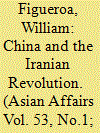

|
|
|
|
|
| Summary/Abstract |
This article examines several under-explored aspects of Sino-Iranian relations in the 1970s, the process of Sino-Iranian rapprochement, and China's reaction to the 1979 revolution. By relying on sources in both Chinese and Persian and pushing back the timeline to 1965, it analyses the role of China's unofficial support for Iranian Maoism on official relations, the personal role of the Shah and the women of the royal family, China's internal view of the Islamic Republic shortly after 1979, and the role of propaganda and performativity in Sino-Iranian diplomacy. In doing so, it sheds new light on old topics and expands on previous studies that focus primarily on the official politics of rapprochement and the post-1971 era.
|
|
|
|
|
|
|
|
|
|
|
|
|
|
|
|
| 3 |
ID:
184396
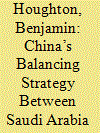

|
|
|
|
|
| Summary/Abstract |
Since Deng Xiaoping's opening-up policy and drive for economic modernisation and reform in the late 1970s, and especially since China's foreign energy requirements skyrocketed in 1993, Beijing's interests in the Persian Gulf have grown immensely. A staple of its regional policy has been an insistence on cultivating relations with all states, something that has necessitated a careful balancing act between regional rivals, especially Saudi Arabia and Iran. This article examines China's strategy to balance relations with these two states, especially during periods of tension, such as following the 2019 drone attacks on Saudi oil facilities, something that Riyadh accused Iran of masterminding. Following an examination of this strategy, the article explores Saudi attempts to coax Beijing away from Tehran and Saudi perceptions of Sino-Iranian relations through the lens of the 2021 25-year agreement between China and Iran, questioning whether Sino-Iranian relations are a bone of contention in Sino-Saudi relations.
|
|
|
|
|
|
|
|
|
|
|
|
|
|
|
|
| 4 |
ID:
184398
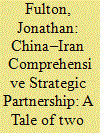

|
|
|
|
|
| Summary/Abstract |
The China-Iran comprehensive strategic partnership (CSP) has been described as a potentially disruptive alignment. This article analyses the impact of the CSP in two regional security complexes (RSCs): the Persian Gulf and South Asia. It finds that of the two RSCs, the China-Iran CSP has a greater likelihood of affecting the strategic landscape of the South Asian RSC as China seeks to contain India's power and influence. In the Persian Gulf, China's economically-motivated regional presence is supported by the maintenance of the status quo, and as a result the CSP is not likely to adversely affect that RSC.
|
|
|
|
|
|
|
|
|
|
|
|
|
|
|
|
| 5 |
ID:
184392
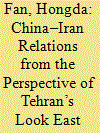

|
|
|
|
|
| Summary/Abstract |
In recent years the Iranian government has emphasised its Look East approach. As a diplomatic choice, the Look East approach has also aroused different understandings among Iranian scholars and in this context, China has received more attention from Iran. For different reasons, many countries have tracked and observed Iran's Look East approach and China-Iran relations. At present, there are many negative perceptions about the Look East approach and Sino-Iranian relations in Iran and the international community. So far, China has made very few official comments on Iran's Look East approach, and this is essentially the case with Chinese scholars and media. China is very concerned about whether Iran's Look East approach is an act of political expediency or a strategy. Some of Iran's actions in the past few years have partially proved the necessity for China to be so suspicious. Although there are some negative views of China in Iran, Beijing should still pay more attention to deepening relations with Tehran. Even if Iran's Look East approach is not a long-term strategy, it is no longer just an expedient measure to deal with Western sanctions. China must be an important goal of Iran's multilateral diplomacy. China and Iran, which need each other, urgently need to increase political mutual trust.
|
|
|
|
|
|
|
|
|
|
|
|
|
|
|
|
| 6 |
ID:
184394
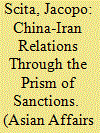

|
|
|
|
|
| Summary/Abstract |
The article aims to understand how China has dealt with the puzzle of Iran's sanctions. Beijing's approach and reaction to the question of sanctioning Tehran and abiding by the sanctions imposed by the United States and the UNSC are a response to a complex matrix formed by three distinct but co-existing dimensions: the bilateral relationship with Iran, that with Washington, and its own positioning within the international community. Each dimension is associated with the performance of a specific international role. What emerges from the analysis of three case studies – the introduction of the 1996 Iran and Libya Sanction Act, the UNSC resolutions imposing sanctions on Iran (2006-10), and the response to Washington's Maximum Pressure campaign – is that, for China, Iran's sanctions are an inherent source of conflicts between its roles. Ultimately, Beijing's responses to the emerging conflicts between its roles have been cautious and aimed at tempering their possible escalations, even though the case studies show that a quite visible hierarchy of roles exists. China's role vis-à-vis Iran occupies a lower position than those performed vis-à-vis the United States and the international community.
|
|
|
|
|
|
|
|
|
|
|
|
|
|
|
|
| 7 |
ID:
184399


|
|
|
|
|
| Summary/Abstract |
The Russian factor in Sino-Iranian relations has been an outgrowth of Moscow's relations with Beijing and Tehran which each occupy distinct, though at times overlapping, roles in Russian foreign policy. Whereas the economic ties between Beijing and Tehran have been crucial in the evolution of Sino-Iranian relations, Russia-Iran relations have been driven by converging security concerns with an emphasis on regional issues ranging from the Caspian Sea to Afghanistan. This article begins with an overview of the convergences in Russia, China, and Iran's view of international order, which has materialised in the nascent collective efforts to contest the basis of ostensibly ‘liberal' norms and practices. It proceeds to examine the Russian and Chinese role in the evolution of the Iranian nuclear programme and joint Sino-Russian collaboration during P5+1 negotiations. Next, it shifts its focus to regional and domestic security through Iran's engagement with the Shanghai Cooperation Organisation (SCO) and through Beijing and Moscow's transmission of sovereignty-boosting practices to strengthen regime stability. Finally, it concludes with Iran's role in Russian efforts to link the Eurasian Economic Union (EAEU) and International North-South Transport Corridor (INSTC) with China’s Belt and Road Initiatives (BRI) as well as the wider efforts at supporting de-dollarisation. Yet, despite ideational convergences and coordination on salient issues, it would be erroneous to suggest the existence of a formidable Russia-China-Iran axis. Rather, the tripartite relationship between Russia, China, and Iran remains an illusory entente – bereft of regularised, institutionalised relations outside of their respective bilateral ties which tend to allow only modest trilateral coordination.
|
|
|
|
|
|
|
|
|
|
|
|
|
|
|
|
| 8 |
ID:
184401


|
|
|
|
|
| Summary/Abstract |
The article takes a critical look at the multiple challenges related to the Indo-Pakistani conflict over Kashmir, with particular focus on the correlation between the countries’ policies and selected human rights (HR) related challenges in Kashmir. In particular, it investigates the post-2019 dynamics, with the major watershed being the abrogation of the semi-autonomy of the erstwhile state of Jammu and Kashmir (J&K) by India. The major objective of this research is to unpack the evolving complexities of the Kashmir situation by analysing holistically how certain key local/domestic, bilateral, and regional aspects influence the conflict’s trajectories and by looking at them from political and HR-related perspectives. The study concludes that domestic, bilateral, and international circumstances make both adversaries prone to bolster their belligerent narratives rather than deal with the issue constructively, by de-escalating mutual tensions and addressing the problems of the indigenous residents of Kashmir. This unresolved dispute stamps its negative imprint not only on Indo-Pakistani relations and the entire South Asian security system but also adversely affects the situation in the pieces of Kashmir administered by India and Pakistan, respectively.
|
|
|
|
|
|
|
|
|
|
|
|
|
|
|
|
| 9 |
ID:
184393
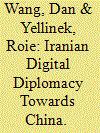

|
|
|
|
|
| Summary/Abstract |
Digital diplomacy is an efficient tool for building close relationships between countries, especially when it comes to people-to-people diplomacy (P2P). This article aims to explore how the Iranian embassy in Beijing uses Chinese social media and reveals the motivations and changes in its behaviour. The main finding was that 2019 was a turning point; before 2019, the embassy messages were more informative without targeting specifically its Chinese audience, and since 2019 the messages have been showing deeper understating the local discourse and, therefore, have been more tailored for its Chinese audience. The main reasons for that were the place of Iran in the China-US trade war, the role of the EU in uplifting Iran's status in the international community, and the Ambassadors' characteristics and background, which switched at the end of 2018.
|
|
|
|
|
|
|
|
|
|
|
|
|
|
|
|
| 10 |
ID:
184400
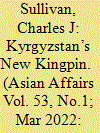

|
|
|
|
|
| Summary/Abstract |
This article analyzes Sadyr Japarov's first year in power as the newly elected President of the Kyrgyz Republic. In learning from the mistakes of his governing predecessors, Japarov is attempting to construct and consolidate an authoritarian system. Japarov may ultimately succeed in this endeavor, but Kyrgyzstan will likely forfeit much of its sovereignty to Russia along with its quasi-democratic institutions in exchange for a strongman-style government.
|
|
|
|
|
|
|
|
|
|
|
|
|
|
|
|
| 11 |
ID:
184389
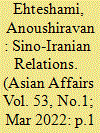

|
|
|
|
|
| Summary/Abstract |
In the fifty years since the People’s Republic of China and Iran formally established diplomatic relations, both states have undergone seismic changes in their domestic environments and foreign relations. In 1971, when the two states formalised their ties, Chairman Mao Zedong oversaw China’s accession to the United Nations following over two decades of autarky and revisionist ambitions, heralding the beginning of the People’s Republic of China’s impressive rise following his death in September 1976 and Deng Xiaoping’s subsequent drive for economic modernisation and reform. Meanwhile, the Shah of Iran, supported by the United States, occupied what appeared at the time to be a stable position as a pillar of Persian Gulf regional security, a role that could not be further removed from that played by the Islamic Republic following the 1979 revolution. Since then, both China and Iran, for different reasons and in different contexts, have been at the forefront of global international relations. In the case of China, its clout has skyrocketed in both economic and diplomatic terms. Its economy is poised to overtake that of the United States, and it has built extensive networks of economic and political interdependencies across the globe. Beijing not only weathered the storms that erupted following the Asian Financial Crisis in 1997 and the Global Financial Crisis a decade later but thrived in their aftermath.
|
|
|
|
|
|
|
|
|
|
|
|
|
|
|
|
| 12 |
ID:
184391


|
|
|
|
|
| Summary/Abstract |
There are many shared historical experiences and similarities between Iran and China. Both are legacies of the long-lasting empires and civilisations in West and East Asia, respectively. Like other great Asian empires, Iran and China were confronted with the expansion of the European imperial powers in the early-nineteenth century which ultimately led to the dislocation of these ancient empires. Both countries had resisted pressures towards peripheralization in the global economy by the creation of nationalist popular revolutions and by building modern nation states and identities in the first half of the twentieth century, despite different political systems, cultures, and external relations. Both Iran and China have been trying to escape from the external pressures and internal socio-economic backwardness by the modernization of their states, societies, and economies via a state-led catch-up development strategy. These efforts led to the rise of China in the late-20th century and the emergence of post-Islamic revolutionary Iran 1978/79 as a ‘contender state' to the hegemony of the United States (US) in West Asia. This development raises two key questions: why did China succeed in rising as an industrialised regional and global power, and has Iran’s development strategy failed so far?
|
|
|
|
|
|
|
|
|
|
|
|
|
|
|
|
|
|
|
|
|